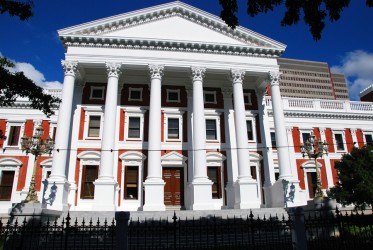2015 Budget: key highlights
 The 2015 Budget was tabled today by finance minister Nhlanhle Nene. It contains a 1% hike in tax rates for middle to high-income earners, increased road accident levies, but also a serious effort by government to curtail spending. Here are some of the key highlights:
The 2015 Budget was tabled today by finance minister Nhlanhle Nene. It contains a 1% hike in tax rates for middle to high-income earners, increased road accident levies, but also a serious effort by government to curtail spending. Here are some of the key highlights:- A 1% hike in tax rates for the middle to high-income earners
- All taxpayers earning more than R181,900 a year will pay 1% more in tax, generating R9,4 billion in additional revenue
- R8,5 billion of this will be returned to those earning less than R450,000 a year in the form of inflation adjusted tax-relief, rebates and medical scheme credits
- The maximum marginal tax rate for individuals is now fixed at 41% for Individuals earning in excess of R 701,300 in the 2016 year of assessment
- Small businesses with a turnover of less than R335,000 a year will pay no tax. This threshold has increased from R150 000 the prior year. The maximum rate falls from 6% to 3%
- Fuel levies have been increased by 80.5 cents (general fuel levy – 30.5 cents per litre and RAF levy – 50 cents per litre) in respect of petrol and diesel with a total levy payable in the 2015/2016 year of 332.50 cents and 413.00 cents respectively. This represents an increase in the region of 25 % compared to approximately 7% in 2014/2015
- The road accident levy will rise by 50c from the R1.04 to help the Road Accident Fund address its accumulated unfunded liability of R98.5bn
- Budget deficit expected to fall to 2,5% in 2017-18 from a level of 3,9% in 2015-16 (and the current level of 4,1%)
- Economic growth likely to slow to 2% this year, down from 2,5% projected in October last year
- Slowdown in economic growth blamed on electricity shortages and weak economy
- Growth only likely to reach 3% again in 2017, effectively derailing the National Development Plan target of 5% growth
- Tax revenue in the current fiscal year was R14,7 billion lower than projected and will likely deteriorate R36 billion over the next three years
- Government’s net borrowing requirement is expected to reach R173,1 billion in 2015-16 (from the expected R180,9 billion) and will fall to R155,5 billion by 2017
- Tax increases will generate R16,8 billion, half of which will find its way back to the poor
- Property transfer duties: all transfer duty on property acquired below R750,000 will be eliminated
- There will also be a decrease in the effective transfer-duty liability for properties acquired up to about R2.3 million, and an increased liability for more expensive properties to 11% of the property value
- R25 billion has been slashed from government expenditure over the next two years
- Real growth in non-interest government expenditure on the main budget will be cut to an average of 2% over the next three years, from 2.5% in 2015-16
- Interest on state debt is the fastest rising item of expenditure, increasing from R115 billion this fiscal year to R153 billion in 2017
- Interest on state debt will come in at a staggering R421 billion over the next three years.
- The consolidated wage bill is expected to grow at a nominal annual average of 6.6% over the next three years
Eskom needs a capital injection of R23 billion which will come from the sale of state assets. The first R10 billion to Eskom will be paid in June, the balance of R13 billion later in the year
Biggest risks
The biggest risks to the Budget are further electricity shortages, slower than expected economic growth, and a trade union movement that is demanding 15% annual wage increases – well ahead of inflation.
Together, these risks can throw the Budget out of kilter.
Tax on investments
Tom Smyth, Supervisor for Tax at Ernst & Young comments on some key changes to tax on investments:
Section 12-I of Income Tax Act – Previously, there was a lack of eligible projects to suit the requirements for the 12-I incentive which was designed to attract investment. To remedy this, the deadline for industrial policy project applications is to be extended from 31 December 2015 to 31 December 2017. That, in conjunction with the lowering minimum investment thresholds, will offer companies big incentives for major Greenfield and Brownfield investments. The combined changes will make the incentive more accessible to companies as government tries to attract more private-sector investment.
Research and Development (R&D) Incentives: Section 11-D – Since their inception on the pre-approval system on 1 October 2012, there have been backlogs in the administration of the R&D tax incentives. Government is spending significant time in establishing a solution to deal with these implementation challenges. Government has addressed some of the “known” issues, such as clinical trials and multi-source pharmaceutical (generics). The issue of third-party funding is still to be addressed. Progress has been made and the private sector is looking forward to this being an effective measure to addressing innovation in increasingly knowledge-based economies.
Special Economic Zones (SEZs) – Government is proposing changes to legislation to incentivise investment and industrialisation within Special Economic Zones (SEZs). As part of the incentives, companies can qualify for a special 15% income tax benefit if at least 90% of their revenue/income originates from within these SEZs. Government is proposing a change to the definition of an eligible company, saying that if more than 20% of its expenditure or gross income arises from transactions with connected persons, it will be disqualified. This is in recognition of the ever-evolving discussion around Base Erosion and Profit Shifting (BEPS). Government is worried that companies will try to artificially shift income to these SEZs to take advantage of this benefit and this is an effort to curb this act. This could potentially have undesired consequences as a result of the stricter requirements for eligibility. There is still much to be done in respect of implementation of current and proposed legislation in respect of SEZs.
Section 12-L of Income Tax Act – The energy-efficiency savings tax incentive will be increased from 45c/kWh to 95c/kWh and extended to cogeneration projects. This is a big incentive that recognises the constrained electricity supply in our country. This is well-received and will provide significant relief for firms with operational challenges and a tough business environment. Cogeneration will also in turn significantly increase the scope of this incentive.
















